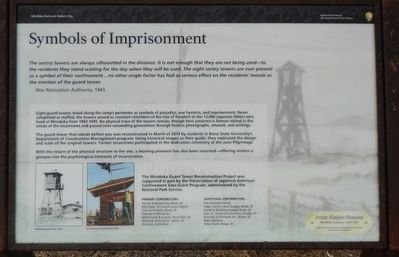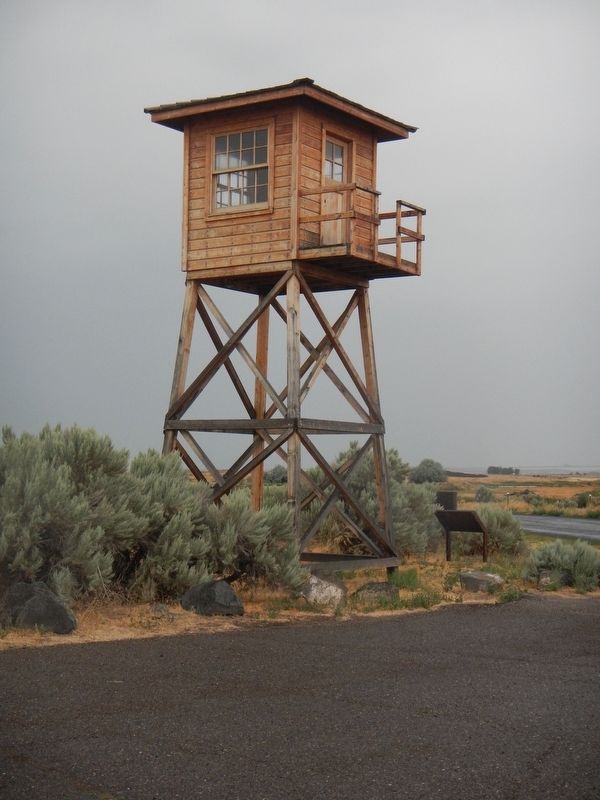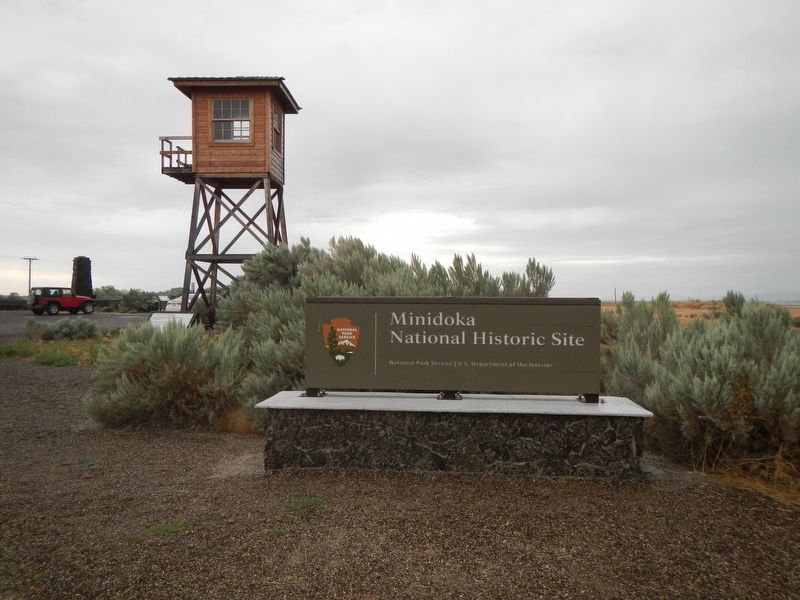Near Jerome in Jerome County, Idaho — The American West (Mountains)
Symbols of Imprisonment
Inscription.
The sentry towers are always silhouetted in the distance. It is not enough that they are not being used - to the residents they stand waiting for the day when they will be used. The eight sentry towers are ever present as a symbol of their confinement....no other single factor has had as serious effect on the residents' morale as the erection of the guard tower. - War Relocation Authority, 1943
Eight guard towers stood along the camp's perimeter as symbols of prejudice, war hysteria, and imprisonment. Never completed or staffed, the towers served as constant reminders of the loss of freedom to the 13,000 Japanese Nikkei who lived at Minidoka from 1942 to 1945. No physical trace of the towers remain, though their presence is forever etched in the minds of the incarcerees and passed onto succeeding generations through historic photographs, artwork, and writings.
The guard tower that stands before you was reconstructed in March of 2014 by students in Boise State University's Department of Construction Management program. Using historical images as their guide, they replicated the design and scale of the original towers. Former incarcerees participated in the dedication ceremony at the June Pilgrimage.
With the return of the physical structure to the site, a looming presence has also been returned - offering visitors a glimpse into the psychological elements of incarceration.
The Minidoka Guard Tower Reconstruction Project was supported in part by the Preservation of Japanese American Confinement Sites Grant Program, administered by the National Park Service.,.
Primary Contributors: Axiom Engineering, Boise, ID; BSU Dept. of Construction Mgmt.; Cole Architects, Boise, ID; Friends of Minidoka; Idaho Sand & Gravel, Twin Falls, ID; Material Testing, Boise, ID ProCore, California
Additional Contributors: The Dimond Family; Edge Construction Supply, Boise, ID; Franklin Building Supply, Boise, ID; Gary D. Jones Construction, Burley, ID; Kowallis & Richards Inc., Boise, ID; Mike Malcom, Tates Rents, Boise, ID
Erected by Minidoka National Historic Site, National Park Service.
Topics. This historical marker is listed in these topic lists: Asian Americans • War, World II.
Location. 42° 40.673′ N, 114° 15.095′ W. Marker is near Jerome, Idaho, in Jerome County. Marker is on Hunt Road near South 1400 East, on the right when traveling east. Touch for map. Marker is at or near this postal address: 1401 Hunt Road, Jerome ID 83338, United States of America. Touch for directions.
Other nearby markers. At least 8 other markers are within walking distance of this marker. Minidoka Relocation Center (within shouting distance of this marker); Soothing Waters (within shouting distance of this marker); On Guard (within shouting distance of this marker); Minidoka National Historic Site (within shouting distance of this marker); A Question of Loyalty (within shouting distance of this marker); Honor Roll (within shouting distance of this marker); Running a Camp (about 500 feet away, measured in a direct line); Censored Mail (about 700 feet away). Touch for a list and map of all markers in Jerome.
More about this marker. This marker is located at the entrance to Minidoka National Historic Site.
Also see . . . Minidoka Relocation Center -- Japanese American Veterans Association. "...These people are living in the midst of a desert where they see nothing except tar paper covered barracks, sagebrush, and rocks…. The impact of emotional disturbance as a result of the evacuation…plus this dull, dreary existence in a desert region surely must give these people a feeling of helplessness, hopelessness, and despair which we on the outside do not and will never fully understand." -- Arthur Klienkopf, Superintendent of Education, Minidoka Relocation Center (Submitted on August 30, 2019, by Barry Swackhamer of Brentwood, California.)
Credits. This page was last revised on August 30, 2019. It was originally submitted on August 30, 2019, by Barry Swackhamer of Brentwood, California. This page has been viewed 246 times since then and 26 times this year. Photos: 1, 2, 3. submitted on August 30, 2019, by Barry Swackhamer of Brentwood, California.


